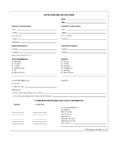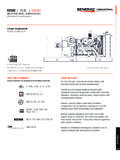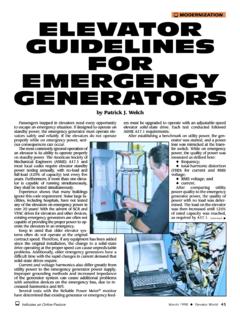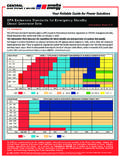Transcription of Information Sheet # 09 Wet Stacking of Generator …
1 The installation Information provided in this Information Sheet is informational in nature only, and should not be considered the advice of a properly licensed and qualified electrician or used in place of a detailed review of the applicable National Electric Codes and local codes. Specific questions about how this Information may affect any particular situation should be addressed to a licensed and qualified electrician. Information Sheet # 09 Wet Stacking of Generator Setsand How to Avoid ItTo fulfill our commitment to be the leading supplier and preferred service provider in the Power Generation Industry, the Clifford Power Systems, Inc.
2 Team maintains up-to-date technology and Information standards on Power Industry changes, regulations and trends. As a service, our Information Sheets are circulated on a regular basis, to existing and potential Power Customers to maintain awareness of changes and developments in engineering standards, electrical codes, and technology impacting the Power Generation installation Information provided in this Information Sheet is informational in nature only, and should not be considered the advice of a properly licensed and qualified electrician or used in place of a detailed review of the applicable National Electric Codes and local codes.
3 Specific questions about how this Information may affect any particular situation should be addressed to a licensed and qualified electrician. Your Reliable Guide for Power IntroductionMost standby Generator systems up to five megawatts use the reciprocating internal combustion engine as the power source to drive the Generator that produces the electrical power. The engines of choice are either diesel, natural gas or LPG fueled. A large percentage of standby power systems use the diesel engine. Diesel is a convenient independent fuel source and the compression ignition systems of diesel engines have a much higher thermal efficiency than the spark ignition system used by gas engines.
4 However, one factor to be considered when selecting a diesel power source is the potential for wet Stacking . The National Fire Protection Agency (NFPA), in their NFPA 110 Code for Emergency and Standby Power Systems section 6 - (1996 edition) refer to wet Stacking as a field term indicating the presence of unburned fuel or carbon in the exhaust system. The later 1999 edition suggests a more quantitative method for determining the presence of wet Stacking by measuring the exhaust gas temperature, explained later in this Information Information Sheet discusses the causes of wet Stacking , its effect on the engine, why it should be avoided and methods for eliminating the condition.
5 The designer of a Generator system must take into account the potential for wet Stacking when determining equipment for the system, load calculations and maintenance and service programs. The system designer should consider the Causes of Wet Stacking : Like all internal combustion engines, to operate at maximum efficiency a diesel engine has to have exactly the right air-to-fuel ratio and be able to sustain its designed operational temperature for a complete burn of fuel. When a diesel engine is operated on light loads, it will not attain its correct operating temperature.
6 When the diesel engine runs below its designed operating temperature for extended periods, unburned fuel is exhausted and noticed as wetness in the exhaust system, hence the phrase wet Stacking . (Continued over)Deposits start building up on piston and ringsleading to loss of performance and wear By pass of rings into oil pan will dilute the oils lubricating propertiesThe first sign of wet Stacking is drips from the exhaust and pooling fuel oilDeposits on valve seats and stems will lowerperformance and cause wear Deposits will foul injectors and reduceengine performanceDeposits on turbo blades will reduce performance and could lead to failureThe effects of Wet Stacking on a Diesel Engine Diagram OneInjectorTurbo-chargerValveLube OilPistonCopyright PLC
7 Enterprises LLCTMCPS-INFO#09 2014 PLC Enterprises, Engine EffectWhen unburned fuel is exhausted out of the combustion chamber, it starts to build up in the exhaust side of the engine, resulting in fouled injectors and a buildup of carbon on the exhaust valves, turbo charger and deposits can result in a loss of engine performance as gases bypass valve seatings, exhaust buildup produces back pressure, and deposits on the turbo blades reduces turbo efficiency. Permanent damage will not be incurred over short periods, but over longer periods, deposits will scar and erode key engine surfaces.
8 (Diagram One) Also, when engines run below the designed operational temperature, the piston rings do not expand sufficiently to adequately seal the space between the pistons and the cylinder walls. This results in unburned fuel and gases escaping into the oil pan and diluting the lubricating properties of the oil, leading to premature engine Why To Avoid Wet StackingIn addition to the adverse engine effect, the designer and user of a system have to consider: Expense - Excessive wet Stacking will shorten engine life by many years and before planned replacement.
9 Pollution - Many urban areas restrict the level of smoke emissions wet Stacking produces. Power - Even before an engine is damaged, deposits will reduce maximum power. A prematurely worn engine will have a lower maximum power than it was designed to develop. Maintenance - An engine experiencing wet Stacking will require considerable more maintenance than an engine that is adequately NFPA GuidelinesWet Stacking is a recognized condition with organizations that write codes for standby Generator set systems, such as the National Fire Protection Association (NFPA) which has issued several guide lines for controlling the NFPA guidelines in Level 1 and 2 applications require exercising the unit at least monthly for 30 minutes under either of two methods:1.
10 Under operating temperature conditions and not less than 30 percent of the EPS name plate kW rating, or2. Loading to maintain the minimum exhaust gas temperature as recommended by the manufacturer. (See NFPA ) Exhaust gas temperature specifications are available from the manufacturer of the Additional ConditionsThe Joint Commission on Accreditation of Health Care Organizations (JCAHO), the organization that accredits health care institutions, has taken this testing to a level beyond the NFPA. They require testing of 12 times per year with testing intervals between 20-40 days.








